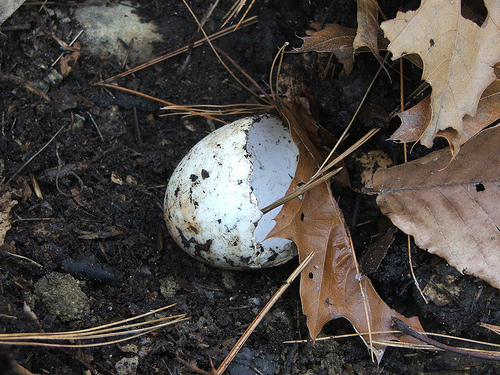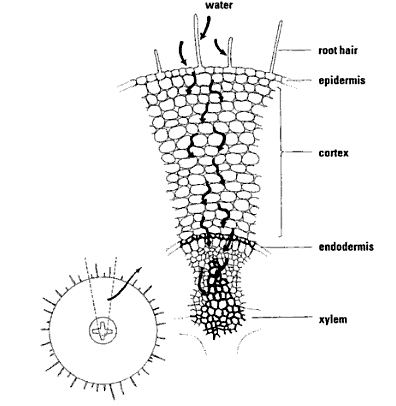This is already the seventh part in a series on how calcium and other nutrients get into the soil and then into plants. Here we finally meet the plant roots, and investigate how they take up water. Click to read part 1, part 2, part 3 and part 4, part 5 and part 6.
~
7. Water uptake through osmosis, turgidity, root pressure and transpirational pull
I’ve given so much attention to the solubility of calcium in water because plant roots can take up nutrients only if they are dissolved in water. Let’s stick with the water for now and add nutrients in part 8. How do plants take up water?
The surface of root tips are made up of epidermal cells (epidermis = outer skin) and their extensions, called root hairs, which form a fuzzy band and increase the absorptive surface area and thus the rate of water uptake several hundredfold. These surface cells and hairs draw water from the soil by osmosis (Greek osmos = a push).
Osmosis happens when there is an unequal concentration of solutes in the water on either side of the epidermis. On the outside, the soil water consists mostly of water with a small amount of salts (any dissolved ions – see part 5). On the inside, the epidermal cells contain water with a much larger concentration of salts, sugars and other substances. The water in the soil seeks to dilute the water inside the epidermal cells, and it pushes, through the epidermis, into the root. The epidermal cell membranes allow this free movement, but only in this direction. If outward movement were allowed, this system would not work, and the root would lose its precious salts and sugars.
The water is stored in the vacuole of the cell, making it turgid or swollen. When the vacuole is fully inflated, the water uptake will slow down, because the internal pressure or turgor inside the cell will squeeze the water out to the next cell, and so up into the rest of the plant, to where it’s needed. You see this effect when you water a wilted plant: slowly all its deflated cells are filled with water through turgidity.
This explains what the problem is with excessively saline soils (see part 5). Even if there is enough water in the soil, it is not diluted enough, and so the inequality between it and the water in the root cells is not large enough, to achieve strong osmosis. Even worse, there might be less water content in the soil water than in the root cells, which reverses the direction of the osmotic flow. Deflated of their torgur pressure, the plant will wilt and, if this continues, die.
Cross section of a plant root
(image from Capon, Brian, Botany for Gardeners, Timber Press, 1990, p.141)
Water constantly circulates into, through and out of the plant. This happens through two specialized vascular tissue systems that run up and down through the entire plant. One is the xylem tissue, which carries water and solutes, and the other is the phloem tissue, which carries mainly organic nutrients, like sucrose. We’re interested in the xylem, which is situated at the center of the root.
To get the water from the epidermis (outer skin) to the xylem, it has to cross another boundary, the endodermis (= inner skin). The endodermis is a second osmotic pump, adding to the pressure (but I’ll return to this one in part 8, because it has to do with how nutrients are taken up). The epidermal and the endodermal osmotic pumps together create root pressure, which moves water (and nutrients) from the root tips to the tips of the leaves, through the xylem.
But just root pressure is not be sufficient to pump water all the way up into the branches of high trees. A second system is necessary for this, called transpirational pull. As the terms suggest, root pressure is a pushing (up) force, from roots to leaves, whereas transpirational pull is a pulling (up) force, from leaves to roots.
Very simply, transpirational pull works like this. Water molecules cohere together, forming an unbroken string or column of water in the xylem, all the way from root tip to leaf tip. When one water molecule is lost at the surface of the leaf through transpiration, or evaporation, the next water molecule is pulled up, along with the whole string of molecules. At the bottom, the roots get to suck fresh water from the soil.
And not just water, of course, but also the nutrients that are dissolved in it. Plants are, however, selective in what nutrients they will allow in: they won’t take up what they don’t need. That in the next part.
~
I foresee one more part (Part 8). Maybe two. But I keep an option on three.


Leave a comment